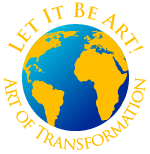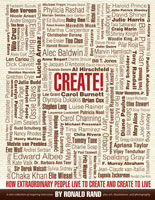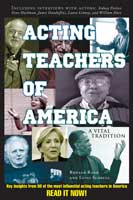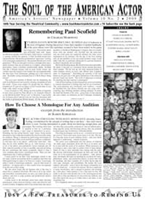
Fulbright Specialist
Directing
Books
Educational Guide for Teachers & Students
Contribute
Investors
International Festivals & Conferences
Essays by Ronald Rand from issues Soul Newspaper
Essays by Harold Clurman from issues Soul Newspaper
Harold Clurman
PBS American Masters
Synopsis in French, Turkish & Spanish
Ronald Rand's Art
Ronald Rand's Poetry
Ronald Rand's Photography
Links
Soul of the American Actor
National Theatre Center
 |
 |
For
Teachers
Harold Clurman and The Group Theatre:
A Celebration and a Call to Action
| Part I & II | Part
III | Part IV | Part
V | Additional Materials | Student & Teacher
Feedback |
Educational Guide - Part IV
IV. WHAT IS THE ULTIMATE SIGNIFICANCE OF THE GROUP THEATRE?
A. The Stanislavsky system, now the predominate technique used in actor
training in America and at many colleges and universities across the
world,
was explored and later taught to thousands of students by Group Theatre members.
Each developed variations of the system taught by Strasberg in the 1930’s,
hoping to address the weaknesses they found in the technique they had learned
from him. Through The Group Theatre’s exploration and their subsequent
efforts to communicate their findings, they offered the American actor a
variety of systematic approaches to analyzing and performing text, defining
a process that would guide the actor in his work.
B. Emergence of the great American acting teachers
Although many Group Theatre members went on to teach, a few became known as
leading experts in actor training, offering a comprehensive approach to the
actor’s process, based on the Stanislavsky system.
1. Stella Adler
Adler’s technique was formed in response to her work with Stanislavsky
in 1934 and her frustration with Strasberg’s teachings, particularly
the use of Affective Memory, which she found more destructive than useful.
Adler’s own technique emphasizes imagination, character work, given circumstances
and actions. Adler’s students worked heavily with script analysis, determining
their characters’ actions (what they physically do on stage), the justification
of those actions (why they are performed), and their overall actions (what
the character ultimately desires to accomplish). Her students also thoroughly
explored the play’s given circumstances, forming characterizations based
on the circumstances that shaped their characters’ behavior. She also
encouraged the use of paraphrasing to help actors take ownership of the author’s
ideas by putting text into their own words.
This set of tools would help actors create a vivid and believable world,
Adler said. She believed that emotion would flow naturally if the tools
were used
effectively. By doing an action fully in a scene, she insisted, the actor
would become emotionally available.
Adler founded the Stella Adler Studio of Acting, where she trained
many, many actors in her technique until her death in 1993. Her Studio,
located
in New
York City, still remains one of the most respected actor training venues
in the country.
2. Lee Strasberg
The system taught by Strasberg following his years with The Group Theatre is
referred to as the Method. It is derived from Stanislavsky’s system,
as it was taught at the American Laboratory Theatre in the 1920’s.
Strasberg’s notes from these Lab classes formed the basis of his teachings
in The Group, which emphasized Affective Memory and relaxation as the central
components of the actor’s process and his key to gaining access to
his own emotions. Strasberg continued to refine his technique in later years,
but these tools remained at its core.
The aim of Affective Memory is to give the actor a way to bring deep
personal emotion to life in the midst of a scene. If the actor could
become conditioned
to calling forth his emotion, he would be able to repeat performances with
high emotional demands night after night with consistency.
Other key components of the Strasberg technique include the use of
relaxation to dissolve tension and encourage free expression, the use
of concentration
and sense memory (which asks the actor to recall sensory sensations, like
the feeling of sunlight or the smell of coffee, so that the actor can use
the memory
of sensations to create a richer and more detailed performance).
a. The Actors Studio
Although Lee Strasberg’s name is virtually synonymous with The Actors
Studio, it was Elia Kazan, Cheryl Crawford, and Bobby Lewis, who founded The
Studio in 1947. Strasberg began teaching classes there several years later,
replacing Bobby Lewis, who moved on to other pursuits. Many notable actors
trained at The Actors Studio, including Anne Bancroft, Ben Gazzara, Paul Newman,
Marilyn Monroe, Geraldine Page, Kim Stanley, Eli Wallach, and others. Despite
popular myths, Marlon Brando, who did some work at The Studio with Elia Kazan,
was not a student of Strasberg’s, but was initially trained, rather,
by Stella Adler.
3. Sanford Meisner
Meisner was a well-respected actor in The Group Theatre who, after working
with Strasberg for a number of years, began to object to some of the principles
of Strasberg’s teachings. Meisner’s primary dispute was with
the use of Affective Memory, a tool which he felt pulled actors out of the
present moment and severed their connection with their scene partners. He
observed that actors working with a memory would drop out of the scene, becoming
introverted and temporarily unavailable.
In response to his work in The Group Theatre, Meisner developed his
own technique, which defined acting as “living truthfully under imaginary circumstances.” This
required actors to have a thorough understanding of the situations their characters
faced and then to simply respond truthfully to what they experienced onstage.
Meisner also emphasized communion, an issue that was also vitally important
to Stanislavsky. Both insisted that the tie between actors needed to remain
strong at all times. To accomplish this, Meisner said, the actor must keep
his attention off himself and on his scene partner. This would help him to
notice and respond truthfully to any changes in his partner’s behavior;
it would also prevent the actor from becoming introverted or over-analytical.
The actor should work from instinct and the heart, Meisner believed, not from
the head. If the actor could learn to listen deeply and respond fully to the
behavior of those around him, this, coupled with his understanding of the play’s
heightened circumstances, would render the actor emotionally available.
To improve the actor’s ability to respond truthfully to a scene partner’s
behavior, Meisner used an exercise called repetition, an important and central
tool in his technique. Offstage imagination exercises helped to prepare the
actors for emotionally demanding moments, but it was essential that the exercise
be used only offstage and left alone as soon the actor entered a scene. Meisner
also emphasized the concept of “doing the doing.” In other
words, actors were pushed to really do whatever they were supposed to engage
in onstage.
They must really work hard to glue together the plate or write the letter
or pack the suitcase, rather than just pretending to do it. This commitment
to
really accomplishing a task generates honest and specific human behavior
and emotions, which are compelling to an audience.
According to Meisner, “character,” in and of itself, does not exist.
The “character” is simply you, responding truthfully within
a given situation.
Meisner went on the head the Acting Department at The Neighborhood
Playhouse School of the Theatre in New York City, where he taught acting
and directed
student productions for over 40 years.
4. Bobby Lewis
Many actors were exposed to the technique devised by Group member Bobby Lewis
through his classes at The Actors Studio, his influential lectures and books,
including Method or Madness?, his work as head of The Yale Drama School and
as one of the leading directors on Broadway for over 25 years.
Lewis’ technique combined many of the tools and concepts embraced by
Adler and Meisner, including the use of script analysis and the “acting
as doing” philosophy. However, Lewis put special emphasis on imagination
and imagery. Acting, he believed, should combine emotional truth and theatrical
style. Characterization was also important part of Lewis’ technique;
this “transformation” was a central step in the actor’s process
that was too frequently skipped, he felt. In contrast to Adler and Meisner,
then, Lewis’ teaching relied even more heavily on the actor’s “limitless
imagination” and emphasized a more stylized approach to interpretation
and staging. Imagery, rather than the psychology of the actor, could be used
to tell the story of a play, Lewis believed, evoking metaphor and emotion in
an equally powerful and even potentially more interesting manner.
5. Morris Carnovsky, Elia Kazan, Harold Clurman, and others
Following their years with The Group Theatre, Carnovsky, Kazan, and many other
Group members, including Phoebe Brand, Margaret Barker, and even Clifford
Odets, went on to teach as well. Clurman himself became an extremely influential
teacher, a topic discussed in more detail in a later section.
To develop his own unique version of the technique he had acquired
from Strasberg, Carnovsky drew upon his extensive acting experience,
his study of Stanislavsky’s
books, and the lessons he had learned in classes with Stella Adler and in rehearsals
with Strasberg. Carnovsky, a lover of Shakespeare, taught actors using the
Stanislavsky system to prepare them to work on the highest poetic masterpieces
with emotional truth and a realistic style. Carnovsky viewed the actor’s
imagination as his greatest tool. Affective Memory, which had eventually
frustrated Carnovsky during his Group Theatre years, was not a component
of his own Stanislavsky-based
technique.
Elia Kazan taught classes at The Actors Studio, which he had helped
to found, but is mostly known for his work as a director. Kazan was pivotal
in transmitting
the values and technique of The Group Theatre to the mainstream through
his work as a leading stage and film director. Some of his most famed
accomplishments
include the stage and film version of A Streetcar Named Desire, the films
On the Waterfront and A Tree Grows in Brooklyn, and stage productions of
All My
Sons, Death of a Salesman, Cat on a Hot Tin Roof, The Dark at the Top of
the Stairs and Sweet Bird of Youth.
C. The Group maintained its sense of artistry, integrity, and community
in the face of the pressures of commercialism
Clurman, in his leadership of The Group Theatre, allowed the organization
to stray from its artistic goals. Although this perpetuated their financial
struggles, The Group could proudly say they never sacrificed their ideals and
accomplished their main objectives: to develop an ensemble technique of acting,
to produce socially meaningful plays that reflected contemporary American life
and concerns, and to develop a playwright whose works embraced their philosophies.
D. Connecting American theatre artists to a rich history and tradition
The Group Idea emphasized that artists function within a rich and complex historical
tradition that all trained theatre artists should be aware of and can draw
upon. Clurman urged actors to learn about all the arts, about history, and
the moral and social concerns of their time. By linking themselves to their
cultural tradition, they would be anchored by a feeling of connection to
something of greater magnitude and significance than their individual selves.
E. The impact on generations to follow
The ideas of Harold Clurman and the work of The Group Theatre has influenced
leading artists in a variety of fields, including such acting teachers as
Bill Esper, Uta Hagen, Wynn Handman, Bill Hickey, Ed Kovens, Terry Schreiber,
John Strasberg, to name only a few. The Group Theatre’s realistic,
emotionally truthful style of acting greatly affected many celebrated actors,
who are admired as skillful and sensitive craftsmen. Among these actors are
Marlon Brando, Al Pacino, Robert De Niro, Robert Duvall, Gregory Peck, Benecio
DelToro, Edward Norton, Maureen Stapleton, Eli Wallach, Anne Jackson, Geraldine
Page, Kim Stanley, Joanne Woodward, Paul Newman, Kim Hunter, Julie Harris,
Colleen Dewhurst and Meryl Streep. All were trained by Adler, Strasberg,
Meisner or a direct descendent groomed by one of the three to teach their
technique.
Beyond this, The Group Theatre influenced the work of many notable
directors, including stage directors Elia Kazan, Arthur Storch, Arthur
Penn, and Gene
Saks, along with film directors Sidney Lumet, Peter Bogdanovich, Martin Ritt,
and John Cassavates. The new style of acting developed by The Group Theatre,
along with their commitment to social realism, also sparked the emergence
of new styles of plays. Playwrights including Tennessee Williams and
Arthur Miller,
without argument two of the most influential figures of the 20th century
theatre, along with William Inge, Lillian Helman, Paddy Chayefsky, and
William Gibson,
were enormously influenced by The Group Theatre’s work.
| To Part V |
| Part I & II | Part
III | Part IV | Part
V | Additional Materials | Student & Teacher
Feedback |
|
|
|











